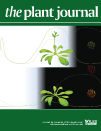- EN - English
- CN - 中文
PCR-based Assay for Genome Integrity after Methyl Methanesulfonate Damage in Physcomitrella patens
PCR检测研究小立碗藓遭受总甲磺酸甲酯损坏后的基因组完整性
发布: 2016年10月05日第6卷第19期 DOI: 10.21769/BioProtoc.1954 浏览次数: 8503
评审: Marisa RosaAnonymous reviewer(s)
Abstract
In plant cells, genomic DNA exists in three organelles: the nucleus, chloroplast, and mitochondrion. Genomic DNA can be damaged by endogenous and exogenous factors, but the damaged DNA can be repaired by DNA repair systems. To quantify the extent of their repair activity of on individual genomic DNA, a PCR-based assay utilizing long amplicons is valuable for evaluable. This assay is based on the inhibitory effects of methyl methanesulfonate (MMS)-induced DNA damage on the amplicons. This assay is useful for assessing DNA double-strand repair pathways, such as homologous recombination repair, as it detects DNA double-strand breaks produced by MMS in vivo.
Keywords: Chloroplast (叶绿体)Background
The quantification of genomic DNA damage is useful for analyzing DNA repair mechanisms. This assay utilizes real-time PCR to quantify the nuclear, chloroplast, and mitochondrial DNA copy number for the normalization of long PCR products, providing more accurate quantification compared with that by the previous protocol by Hunter et al. (2010).
Materials and Reagents
- 90 mm plastic Petri dish
- 50 ml tube
- 1.5 ml tube
- Physcomitrella patens protonemal cells (cultivated for 4 days)
- BCDAT medium (Nishiyama et al., 2000)
- Methyl methanesulfonate (MMS) (Sigma-Aldrich, catalog number: 129925 )
- Chloroform (Sigma-Aldrich, catalog number: V800117 )
- Ethanol (Sigma-Aldrich, catalog number: 09-0770 )
- RNase A
- LA Taq (TAKARA BIO, catalog number: RR002A )
- Agarose powder (Promega, catalog number: V3125 )
- 0.7% agarose gel
- Ethidium bromide (EtBr)
- Power SYBR® green PCR master mix (Thermo Fisher Scientific, Applied BiosystemsTM, catalog number: 4367659 )
- Hexadecyltrimethylammonium bromide (CTAB) (Sigma-Aldrich, catalog number: H-5882 )
- Sodium chloride (NaCl) (Sigma-Aldrich, catalog number: 28-2270 )
- Tris-HCl, pH 8.0 (Wako Pure Chemical Industries, catalog number: 206-07884 )
- Ethylenediamine-N,N,N’,N’-tetraacetic acid, disodium salt, dihydrate (EDTA) (DOJINDO, catalog number: 345-01865 )
- PEG8000 (MP Biomedicals, catalog number: 02194839 )
- Oligonucleotide DNA primers for long amplicon quantitative PCR:
Nuclear DNA (5′-GTGGAAGTGAGATGCAGTTTGG-3′ and 5'-GTGGCTCTGGACAGTGAAATTG-3′)
Chloroplast DNA (5′-AATTGGAGTCGGTCCTTCCATA-3′ and 5′-TGGCAAATACAATGGCAAAAAG-3′)
Mitochondrial DNA (5′-GACTGCCCTCACTAGGATGCTT-3′ and 5′-TGGGTGATTTACTCCATTGACG-3′) - Oligonucleotide DNA primers for short amplicon quantitative PCR:
Nuclear DNA (5′-CAACCGTCTTCTGTGTCTAGGTC-3′ and 5′-GAAACCGGCCTGCATTACATG-3′)
Chloroplast DNA (5′-AGTAATCCCATCGCGTGACAT-3′ and 5′-AGGTATGGAAAAAATCGCTGAAAA-3′)
Mitochondrial DNA (5′-CGTGCTAAAAATCCAGTCCATTC-3′ and 5′-AGCAAAGAAGTCAAGACCTAACAAAAC-3′) - 2x CTAB buffer (see Recipes)
- 10% CTAB (see Recipes)
- CTAB ppt buffer (see Recipes)
- NaCl-TE (see Recipes)
- TE buffer (see Recipes)
- PEG solution (see Recipes)
Equipment
- Forceps
- Multi-beads shocker (Yasui Kikai)
- Vacuum pump (Tokyo Rikakikai, catalog number: AS-3 )
- Bench top centrifuge for 1.5 ml tubes
- Heat block for 1.5 ml tubes (TAITEC, catalog number: DTU-2CN )
- Standard thermal cycler (Bio-Rad Laboratories, catalog number: 170-8720JA )
- Real-time PCR thermal cycler (Thermo Fisher Scientific, Applied BiosystemsTM, model: Applied Biosystems® 7500 Fast Real-Time PCR Systems )
Software
- ImageJ (https://imagej.nih.gov/ij/)
- Excel (Microsoft)
Procedure
文章信息
版权信息
© 2016 The Authors; exclusive licensee Bio-protocol LLC.
如何引用
Odahara, M., Inouye, T., Nishimura, Y. and Sekine, Y. (2016). PCR-based Assay for Genome Integrity after Methyl Methanesulfonate Damage in Physcomitrella patens. Bio-protocol 6(19): e1954. DOI: 10.21769/BioProtoc.1954.
分类
分子生物学 > DNA > DNA 损伤和修复
植物科学 > 植物分子生物学 > DNA
您对这篇实验方法有问题吗?
在此处发布您的问题,我们将邀请本文作者来回答。同时,我们会将您的问题发布到Bio-protocol Exchange,以便寻求社区成员的帮助。
提问指南
+ 问题描述
写下详细的问题描述,包括所有有助于他人回答您问题的信息(例如实验过程、条件和相关图像等)。
Share
Bluesky
X
Copy link












